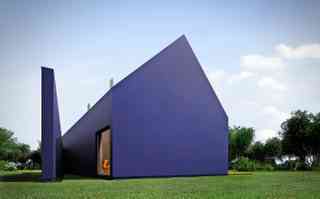
Plastic was invented by Alexander Parkes in 1856, and since then our modern world has come to rely on the versatile material for just about everything. But architecture, until recently, has used materials with more perceived staying power, both physical and aesthetic, such as wood, metal, glass, and stone. Plastic has long carried the connotation of disposable or cheap, but as today’s architects have come to recognize, it’s anything but. Whether used as a thin film, a pliable sheet, or as a piece of sculpture, plastic (in its many incarnations) can adapt to the desires of architect and the needs of a project. What’s more, it inherently possesses a sleek, futuristic look that natural materials can’t match. Here, AD rounds up some of the most innovative buildings, some temporary and some not, that explore the many possibilities of plastic.
This stealthy matte-black home in Poland is clad in Thermopian, an insulating plastic typically used for roofing. The house, which features a distinctive exterior wall that mimics an open door, is the work of Moomoo Architects.

The National Aquatics Center in Beijing features a skin made with ETFE, a durable plastic used for roofing, inspired by soap bubbles. Informally known as the Watercube, the structure was designed by PTW Architects and Arup, an engineering firm, for the 2008 Summer Olympics.

From the front, this rowhouse in Dublin looks like all the rest. The back, however, reveals a plastic addition that encapsulates a kitchen, a bath, stairs, and a storage space, and provides natural light for the rest of the interior. Plastic House, as it’s known, was designed by Architecture Republic.
The white concrete walls of this building in Albacete, Spain, are surrounded by a net of perforated plastic, a means of making the structure less static to the eye. Designed by Cor & Asociados, the space is the headquarters for the Confederation of Employers of Albacete, a nonprofit that aids local businesses.
Corrugated plastic affixed to a timber frame forms the façade of Light Shed in Kanagawa, Japan, by FT Architects. Situated in the backyard of a photographer’s house, the building serves as a photo studio, perfectly lit by light filtering through the plastic.
Hotel Kapok, known colloquially as the Blur Hotel, features a gridlike exterior made of a fiberglass-reinforced plastic over glass. Inspired by a Chinese lantern, the structure designed by Studio Pei-Zhu glows from within at night.
Known as Tony’s Farm, this structure in Shanghai is made from green plastic shipping containers. Located on the city’s largest organic farm, the building by Studio Playze accommodates a lobby, common rooms, a VIP area, and future hotel rooms.
Engomi, Cyprus, is home to the Architecture Research Center at the University of Nicosia in a building that once housed a shoe factory. Covered in multicolor polycarbonate panels, the structure—designed by Petros Konstantinou and Yiorgos Hadjichristou Architects—provides ample light for the students studying architecture within.
The 15th Serpentine Gallery Pavilion, designed by SalgasCano for the eponymous art venue in London, was made with strips and sheets of translucent, colored ETFE plastic. The outdoor structure served as a venue for parties and gallery talks while it was open.
Designed by ACXT, the San Mamés Stadium in Bilbao, Spain, boasts a façade of twisted white panels made with ETFE plastic. The stadium, on the edge of the city, houses a soccer field and seats 53,000 people.
